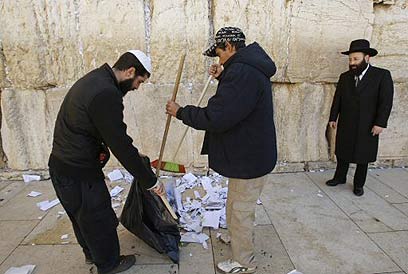 Jerusalem – The ancient crevices of the Western Wall, filled with prayer notes tearfully tucked inside by tens of thousands of worshippers during the course of the year, underwent their twice-yearly cleaning-out on Sunday, under the watchful eye of the Rabbi of the Holy Sites, Rabbi Shmuel Rabinovich.
Jerusalem – The ancient crevices of the Western Wall, filled with prayer notes tearfully tucked inside by tens of thousands of worshippers during the course of the year, underwent their twice-yearly cleaning-out on Sunday, under the watchful eye of the Rabbi of the Holy Sites, Rabbi Shmuel Rabinovich.
Subscribe to our Daily Roundup Email
The notes are emptied out of the Wall just before Passover and just before Rosh HaShanah. The purpose is to make room so that people can “insert their prayer notes at the Wall without fear that the notes will fall out and be trampled upon,” Rabbi Rabinovich explained.
The notes, many of which contain the full names of family members, as well as requests for health, sustenance, a spouse, solutions for personal problems, and more, are treated with great respect by the workers. The workers even immerse themselves in a mikveh (ritual bath) before beginning the holy work of removing the notes.
The notes are removed without the use of metal bars or utensils – which stand for warfare and the taking of life (see Exodus 20,22) – but rather with wooden rods. Following their removal, the notes are taken to the nearby ancient Mt. of Olives cemetery for burial.
Tour Guides Don’t Know Everything
Many people are not aware of the notes’ ultimate fate. Just a few days ago, in answer to a question on this topic, a licensed tour guide was heard explaining to his group of Harvard Law School student tourists, “Let’s put it this way: No one goes and sweeps out all the notes. They sort of just fall out on their own…”
Rabbi Rabinvoich said. “Any Jew, or anyone else, knows that if he prays to G-d, his prayer his heard, as King Solomon said when he built the Temple. One who leaves a note here can be sure that even if it is taken away, G-d hears the prayer.”
Checking the Wall
Also twice yearly, tests are done on the Wall to make sure that the giant stones are holding fast and that the Wall is not leaning. “You can see the crane here now,” Rabbi Rabinovich told an interviewer from Ladaat.net, “engaged in those very tests, to make sure that no one will be endangered, Heaven forbid.”

Rabbi Shmuel Rabinowitz is quite active; The Pope, the women, and the notes. I wonder where he got this brand new halacha that notes are not to be removed with a metal utensil.
Meheicha tesey that we write our tefillos? Tefillah is B’peh. I never understood this minhag of writing a tefillah and placing it in the wall. Hashem Sefasai Tirtach U’fi Yagid Tehilasecha.
why can’t you just throw them in the trash?
Qoute; “The workers even immerse themselves in a mikveh (ritual bath) before beginning the holy work of removing the notes”.
Just wandering if the guy holding the broom also immersed??
what about that stupid yeshiva bochur that stole Barack Obama’s note the day he put it in and gave it to the newspapers? mamish a chilul hashem of the highest order
It is an Issur Deoreisa to use metal tools on the stones of the beis hamikdush. “Ki Charbacha Heinaftu uleihu vatechalelahu”. That is why Shlomo Hamelech used the Shamir to cut the stones. We also do not use metal tools to cut tzitzis. They use plastic knives.
B”H
I may be wrong, but I believe that the author of #16 is a woman, like myself. She is correct in stating that most of the women do follow the halacha of walking backwards until they reach the line where the separation between the sides ends.
And please, let us all show a little more ahavas yisroel. There have been some surprisingly and upsettingly derogatory remarks made about our fellow yidden in this thread. Considering this audience, I imagine I need not remind everyone about the dangers of lashon hara.
Shlomo didn’t build that wall, Herod did. He used metals on it, including lead to leverage and bind the stones.
The bottom of the Kosel dates before herod. Herods stones start where we would see the second or third line ( the stones with the square border inlay)
It’s good to hear the notes are “treated with great respect”. It’s people’s prays in which they believe.